Branch Lines & Ferries
Last updated 2012, apart from chapters with newer data
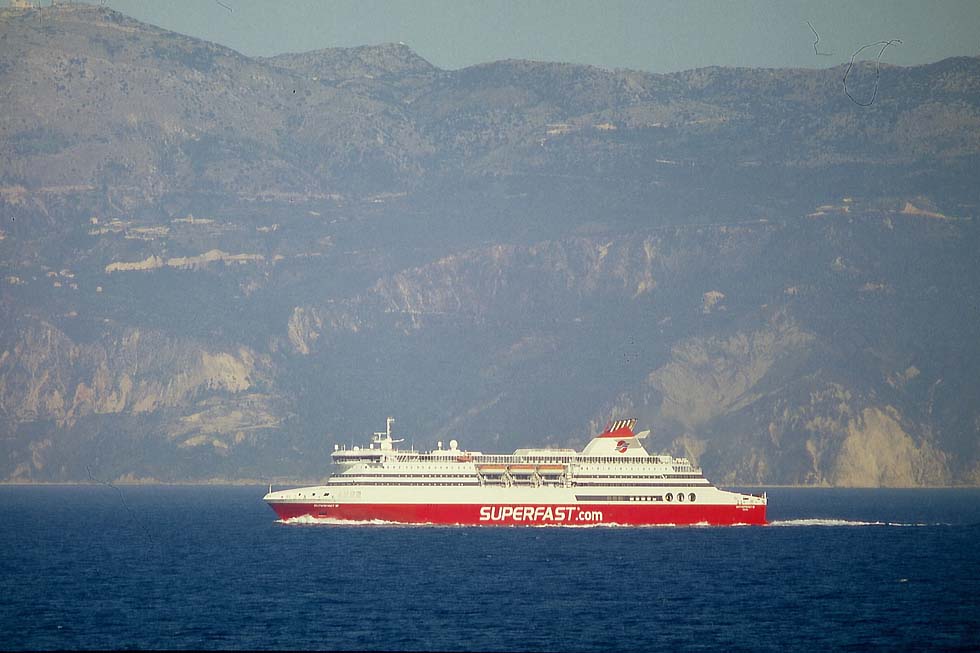
"Superfast VI", Patras - Ancona 2007 (WS)
The branch lines of the grand shipping companies combined with mail and cargo services, as well as local steamer lines under mail contract provided in the past the sole connection to places which could not be reached otherwise. Forming a part of the worldwide transport and communications system - and of colonialism in past times - they were indispensable, as the car ferries are nowadays, transporting passengers, motor cars, buses and trucks. In contrast to the old enterprises in transoceanic passenger shipping, ferry companies have not the status of national icons and the last subsidized relics of the past had to disappear. More than half a thousand companies are providing ferry services now, car-carrying or not. At least half of all car ferries operate local short-haul services, generally not listed by that survey, apart from a few exceptions. Also inland navigation is not a subject of this review, neither the worldwide market of ro-ro ships, carrying every sort of car but no passengers.
Geography
Contrary to the branch lines of the worldwide operating ocean liner companies of the past, the ferry business generally is divided up by regions and there are still subsidized national institutions competing with private companies. Among the few companies with worldwide activities, the best-known one has been the Sea Containers Group, founded in 1965 by James B. Sherwood, a retired U.S. Navy officer. The Bermuda-registered company filed for insolvency protection in 2006, "... victim of their own scatter-gun approach to business acquisition and their inability either to understand or to reinvest significantly in which they operated" (Bruce Peter: Baltic Ferries). In 2009 Business Week reported restructuring and mentioned the previous ferry and hi-speed activities in the Irish Sea, Channel, Baltic Sea, Adriatic Sea and in New York harbour - see the relevant chapters. James Sherwood lost also his railway enterprises and resigned. A few other companies started widespread activities, e.g. Superfast Ferries, but reduced it in time. Then the Grimaldi Naples Group extended its car ferry business far beyond its region.
A look at the timetables, hundred years ago and nowadays, shows that the seas surrounding relatively small Europe had - and have - an exceptionally great number of shipping services and companies. ShipPax Information's Statistics & Outlook 06 stated that among roughly 1,200 car ferries worldwide, c. 700 are operating around Europe, c.300 on the Pacific Rim and slightly more than 100 in the Americas. The few services between North, Central and South America generally are only for truck transport. By the number of passengers, Asia/Pacific is leading. With India and China becoming 'auto-based' nations, new markets must develop to an unprecedented extent. Typical branch lines of the past covered much longer routes than nowadays' ferries. Among the passenger ferry routes during the first decade of the 21st century, Sete - Tangiers (690 nm, 36 hours), Qingdao - Shimonoseki (1,078 nm, 42 hours) and Bellingham - Skagway (950 nm) were examples of relatively long distances. Success is based more and more on the transport of trucks and trailers, nevertheless, more than 1.3 billion passengers worldwide have been estimated by ShipPax e.g. for the year 2004. That means at least hundredfold the number of cruise passengers, on shorter travels however. Among the European ferry-ports, Dover with c. 13 million passengers per annum was described as the leader, followed by Helsingborg and Messina, harbours engaged mainly in short-haul traffic. Piraeus with substantially longer shipping routes has claimed to have 13 million passengers annually, too.
Car Ferries' Development
ShipPax considered the "Motor Princess", introduced in 1923 by Canadian Pacific at Vancouver, being world's first car ferry. Ships Monthly (Sept. 2007) mentioned the "Bardic Ferry" and "Ionian Ferry" of the 1950s as the first purpose-built roll-on-roll-off vessels. Historian Mike Ball replied by suggesting that the honour belongs to "Daily", introduced already in 1913 by the Puget Sound Navigation Co. During the 1960s, many car ferries were measured with 5,000 gt or less and later the same ships were registered with twice the size and more. Among the car ferries of that period were rebuilt passenger ships and even tankers. Initially the comfort of the ferries was mediocre at best. Nowadays, up-to-date car ferries are equipped with restaurants, lounges and cabins with toilet and shower. The technical equipment and passenger facilities have reached the standard of modern cruise ships and many ferries are much faster. The "Finnjet" of Finnlines, built in 1977 (then the largest ferry in the world, her tonnage being 24,605), carried 1,781 passengers, 325 cars and 50 trucks at a speed of 30.5 knots, powered by gas-turbines, uneconomic however. Geared diesel engines in combination with conventional propellers are the standard of ferries.
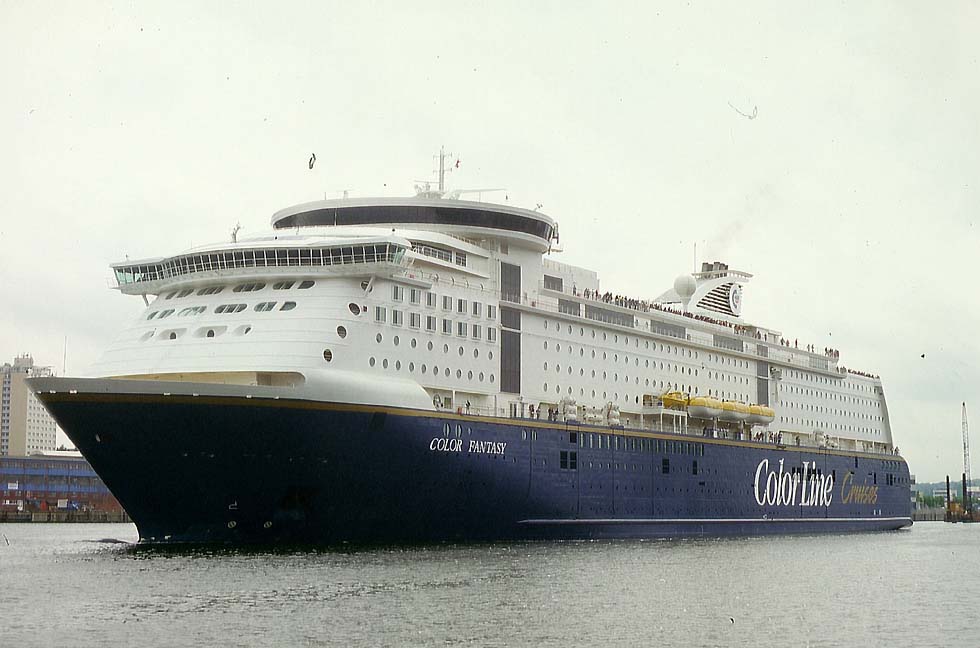
"Color Fantasy", Kiel - Oslo 2007 (WS)
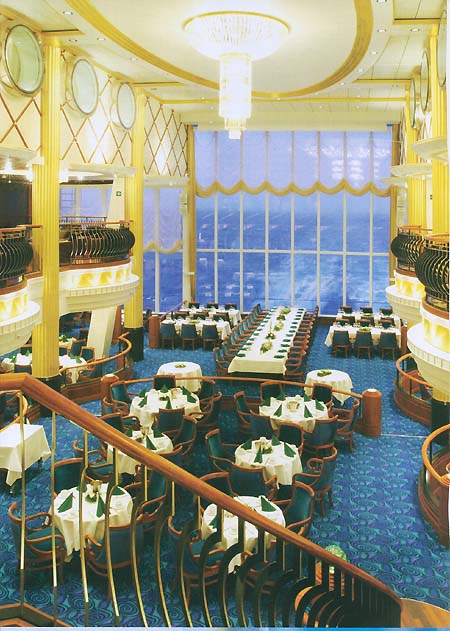 "Color Fantasy" dining-room (Color Line)
"Color Fantasy" dining-room (Color Line)
When the concept of this review has been put down, the "Color Fantasy" of Color Line was the most prominent ferry of the time. Built in 2004 at the Finnish Kvaerner Yard with a tonnage of 75,072 and laid out for a speed of 22 knots, she provides cabins for 2,750 passengers and storage for 750 cars. Classified as a cruise ferry, her comfort is comparable to cruising megaships, including a 'Promenade', Royal Caribbean's unique feature. Contrary to ocean liners or cruise ships however, the fare for a ferry trip generally does not include meals - the reason why many passengers are content with a self-service buffet, though the cruise ferries generally are equipped also with an excellent full-service restaurant.
The other end of the category is represented by Asian ferries with economy-class sleeping-halls. However, they are still more comfortable than the seats offered by many European companies for night journeys. In a time of rising fuel cost, design must meet the necessities of the enterprises, economy, a high capacity for trucks and a speed around 25 knots being the demand of the day.
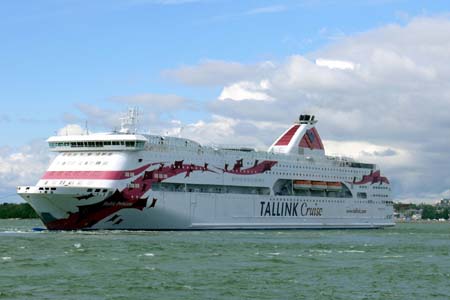
"Baltic Princess", a cruise ferry of Tallink (Akeryards/ STX Europe)
|
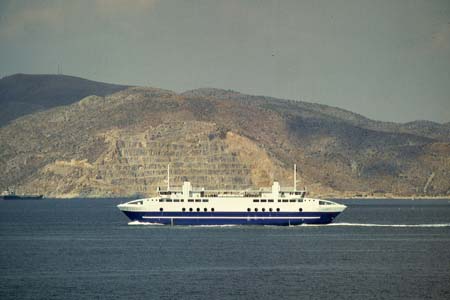
"Achaios", a double-ender of 2wayferries, Greece 2006 (WS)
|
Only on short routes time can be saved by the introduction of double-ender ferries in order to avoid turning maneuvers at the terminals. The catastrophe of the "Estonia" in 1994 showed the limits of that technology. On a nightly Tallinn - Stockholm passage she capsized during a storm after the bow door had opened, and 895 people went down in the icy sea. With a 10 hours' stay in the port of Tallinn and 8 hours at Stockholm, bow-loading was absolutely unnecessary.
Hi-Speed Development
Already in 1716 the Swedish theologian Emanuel Swedenborg had the idea of the air cushion principle. In the 1950s the British engineer Christopher Cockerell invented the hovercraft technology, based on that principle, equipped with a rubber skirt. Saunders-Roe of the Isle of Wight showed interest and completed the first hovercraft, the "SR.N1" or Saunders Roe Nautical One, in 1959. After the first Hovercraft service had been opened between Dover and Calais, further models basing on this principle have commenced operation. Gas-turbines provided the power for both hover-lift and forward propulsion, transmitted by airscrew pylons. All that, however, could not help to make this kind of technology a permanent success and due to economic reasons, hovercraft services disappeared. Nevertheless hovercraft vessels were commissioned by coast guards and oil companies.
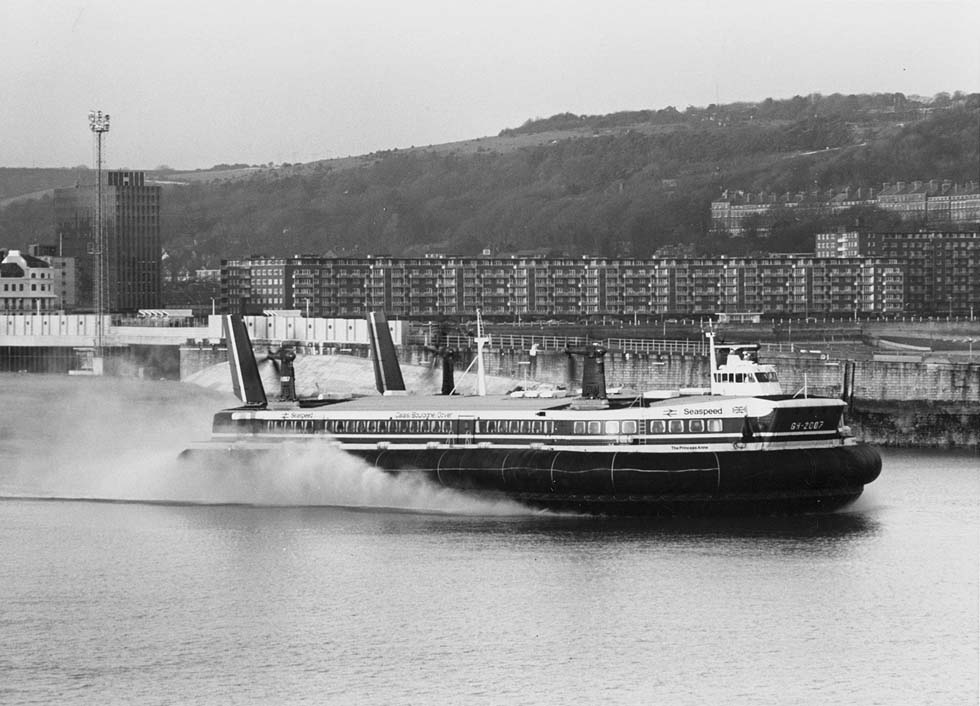
"Princess Anne" of Seaspeed, departing from Dover, 1979 (WS)
Small hydrofoils, used for inland shipping and also for short sea routes, were developed earlier, mainly in the USSR. From 1943 the Raketa type for 64 passengers and the Kometa type for 116 passengers were built.
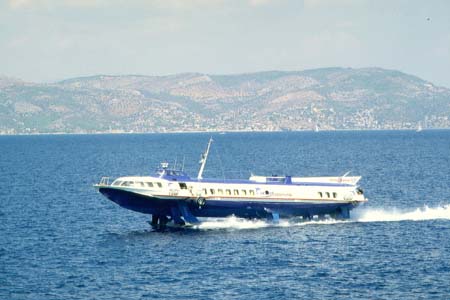
Kometa type "Flying Dolphin 3" of Hellas Flying Dolphins, 2002 (WS)
|
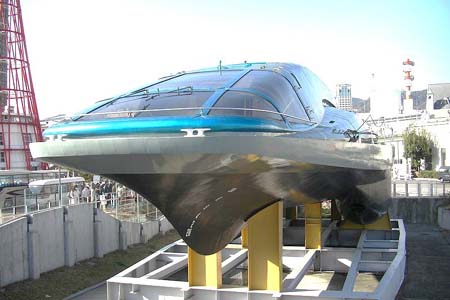
"Yamato" at Kobe Maritime Museum (via Wikimedia)
|
An attempt was undertaken with the 'Surface Effect Ship' technology, developed by Fincantieri in Italy, not to be confused with the hovercraft. With the SES1000 proposal a vessel for 600 passengers and 48 knots was targeted. From Russia came the RSES-500 proposal. In Japan the 'Techno Superliner' with a length of 140 m and a speed of 40 knots was built in 2005, laid up however (information according to Jane's High Speed Marine Transportation 2009). 'SWATH' is another concept for twin-hull vessels. The "Yamato", described as a 'superconducting electromagnetic propulsion boat', is a futuristic experiment in Japan.
Multihull
At present, around 170 among the hi-speed vessels carry motor cars and most ones are used in the Mediterranean. Generally designed for fast daylight journeys, they are equipped with Pullman-type seats. Among all the hi-speed vessels worldwide roughly half the number comprises catamarans, followed by monohulls. Shipbuilders in the 19th century already have rediscovered the principle of the catamaran (a double hull vessel in use for long time in the South Pacific) as being suitable for ferry operations. Australian shipyards continued the development for high-speed catamarans. In 1990 the InCat Yard of Hobart in Tasmania launched the "Hoverspeed Great Britain", which covered on the transfer to her owner the North Atlantic over a distance of 2,800 nm between Ambrose Lightship and Bishop Rock in 3 days 7 hours and 54 minutes, attaining an average of 36.5 knots. Only four weeks later Scandlines of Denmark took delivery of the "Cat-Link V", which covered the Blue Riband course in 2 days 20 hours and 9 minutes at a speed of 41.28 knots, topping 48.2 knots, enabled by a twin diesel set delivering 19.258 hp. It must be noticed that these vessels have not been built for racing sports. The remarkable records brought about the question, whether they should not be awarded the Blue Riband, since the present holder, the "United States", had set the record "only" at 34.7 knots on a regular east-west crossing. The majority of maritime historians however have rejected the claim because neither of the vessels is a North Atlantic passenger liner. The imaginary Blue Riband remained with the Stars and Stripes. In 2005 the first Trimaran, the "Benchijigua Express" was delivered to Fred. Olsen by Austal. InCat answered in 2006 by building a 112-metre long wave-piercing catamaran for up to 1,400 passengers, 412 cars and 44 knots, developed from the 98m InCat. The largest catamarans were the 19,698-ton HSS hi-speeds, gas-turbine-powered and suffering under high fuel prices.
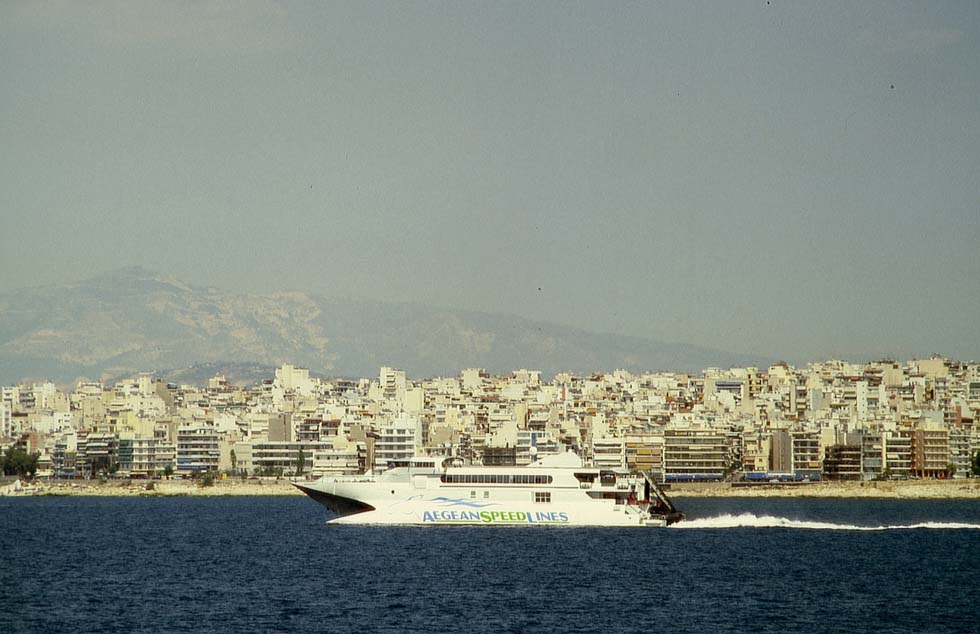
"Speedrunner 1", the former "Hoverspeed Great Britain", Piraeus 2005 (WS)
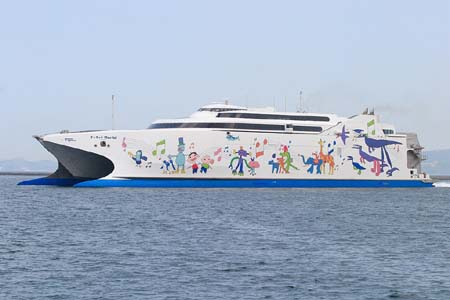
"Natchan World", 112m-InCat of Higashi-Nihon at Aomori (Vieuw751, via Wikimedia)
|
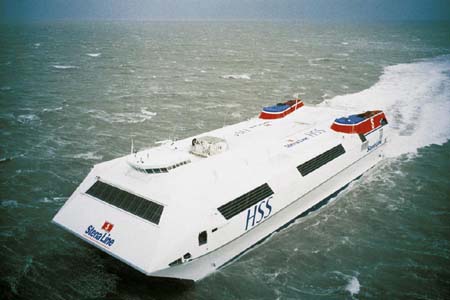
HSS "Stena Explorer" (Akeryards/ STX Europe)
|
Monohull
French, Italian and other shipyards have developed monohull hi-speed ferries. Fincantieri with its MDV type had profited from experiences with the "Destriero", an experimental gas-turbine powered waterjet monohull, sponsored by Aga Khan and Giovanni Agnelli, which crossed the North Atlantic in 1992 within 58 hours and 34 minutes at a speed up to 66 knots. The other Italian pioneer is Rodriquez with the TMV monohulls. In France the Corsaire types were built by Leroux et Lotz, then Alstom. Generally almost all the hi-speeds, catamaran or monohull, have in common the 'waterjet' propulsion, a marine system which creates a jet of water for propulsion with nozzled propellers of a much higher rpm than conventional screws, providing the 'jet' effect. The monohull "Silvia Ana L" of the Spanish Alhambra type for example, built in 1996, was described by Ships Monthly as being "powered by six Caterpillar engines and four powering steering water jets, with two more linked to a central booster jet". Rising fuel cost however proved a problem for hi-speed vessels. With a fuel consumption of 2.5 cubic metres per hour, the catamaran "Hoverspeed Great Britain", then the "Speedrunner 1" of Aegean Speed Lines, proved much more economic than e.g. the "Speedrunner 2", a Fincantieri-built monohull, consuming twice as much, as an engineer of the company told the author. When in Greece the extra-fare catamarans of HSW are laying idle during winter months, it is not caused by a lack in sea going abilities, but by economic reasons, as an official confirmed. Another matter is the sea-sickness aboard every sort of hi-speed at rough weather.
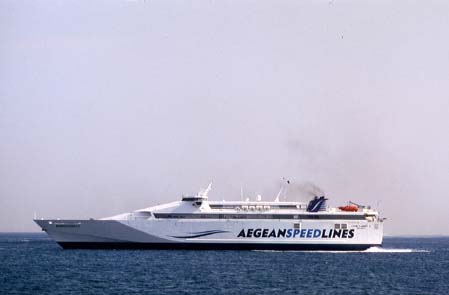
"Speedrunner 2" approaching Piraeus, 2010 (WS)
|
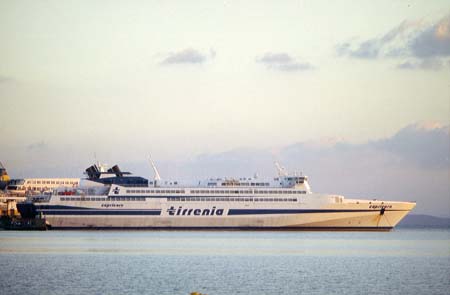
"Capricorn" from Civitavecchia at Golfo Aranci, Sardinia 2006 (WS)
|
Ro-Pax
"The most obvious trend is towards ro-pax", concluded ShipPax Statistics & Outlook 06. Over years within the Baltic region a rise in passenger numbers by 38 percent, in trailers however by 65 percent, was recorded (according to HANSA no.9, 2008). The principle of ro-ro ships, generally roll-on-roll-off cargo vessels without passenger accommodation, developed into ro-pax vessels, offering also comfortable amenities for passengers. Compared to the extremely luxurious ferry "Color Fantasy", designed for 2,750 passengers and 1,280 car-deck lane metres, the ro-pax "Finnstar" of Finnlines provides 4,200 lane metres, mainly for trucks and trailers, and is with a speed of 25 knots faster than the "Color Fantasy", laid out for 22 knots. Stena Line commissioned in 2006 two ro-pax ships of 63,500 tons for delivery in 2010, the "Stena Britannica" (II) and "Stena Hollandica" (II), each with a capacity of 1,200 passengers and 5,500 lanem, being built at Wismar. Leaders in lanemetre capacity became the Grimaldi enterprises. In passenger traffic, ferries are hardly competitive on routes served by low-fare airlines and losses were reported from Scandinavia as well as from the Aegean when the slowdown of 2008 hit every industry. Nevertheless the 54,310-ton "Cruise Roma" and sisters of the Grimaldi Group Naples, though being equipped with 3,040 lanemetres, are comfortable cruise ferries, too.
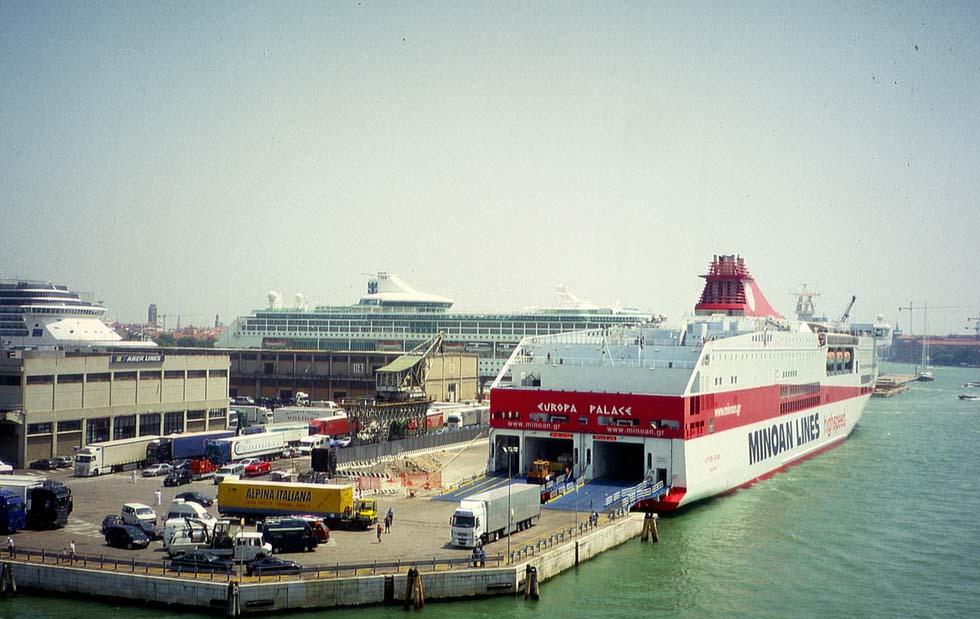
"Europa Palace" bound for Patras, at Venice 2006 (WS)
Future
Generally the future development must be influenced by rising fuel prices. The fuel consumption during a 24 hour operation was published for the "Color Fantasy" with 120 tons and for "La Superba", with 28 knots much faster, with 274 tons. Lower fuel consumption and improved technologies are requested also in consideration of the environmental issue. In 2008 Viking Line presented its extremely futuristic ICON project. Whether those ideas and LNG fuel will influence ferry construction, must be proven. In any case, technologies under development for cargo shipping will influence the technology of ferries, too. A new design feature, the 'X-Bow', was developed by Norway's Ulstein group, targeting amelioration in sea-going capabilities and a reduction in fuel cost. The "Bourbon Orca" was the first vessel of this sort and development continued.
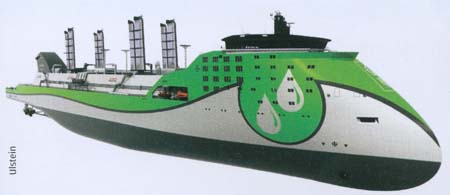 A design by Ulstein group with X-Bow (Ulstein)
A design by Ulstein group with X-Bow (Ulstein)
The most important concern of passengers is safety. A number of catastrophes have pointed out that problem. Safety lacks were criticized and analyzed by the media. The German newspaper "Welt am Sonntag" reported in 2006, that 11 of 12 of the worst shipping disasters between 1990 and 2006 have concerned ferry boats. This unfortunate record gave reason to intensive researches. The "free surface effect" of car-ferries caused building thoroughly shaped wider hulls. Highly combustible materials were banned. Regular safety tests have led to a highly upgraded standard, at least on routes of the wealthy countries.
After the end of ocean lines' connecting branch lines, the ferry business became a sort of successor. Aesthetic aspects of course are primarily prevailed by technical preconditions. Nevertheless, today's sleek style makes forget the purely functional look of many ferries built decades ago. Certain cruise ferries have a more pleasant appearance than some cruising megaships.
On certain routes the car ferries are also a successor of railways' once-elegant "Grand European Expresses", which have vanished like the ocean liners. Interior design of modern car ferries generally is of a contemporary style, more sober than some cruise ships' decoration. And up-to-date cruise ferries are providing every comfort necessary, otherwise this market could suffer a decline like railways' once 'grand' European long-distance expresses, which disappeared after they had decayed.
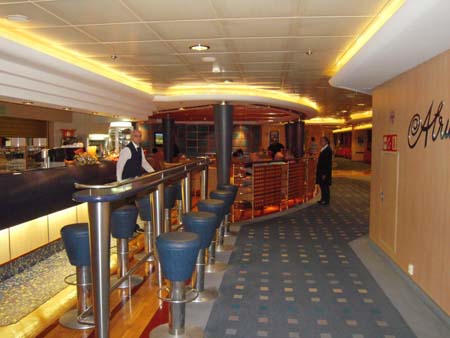
"Olympic Champion" of ANEK, the bar (WS)
|
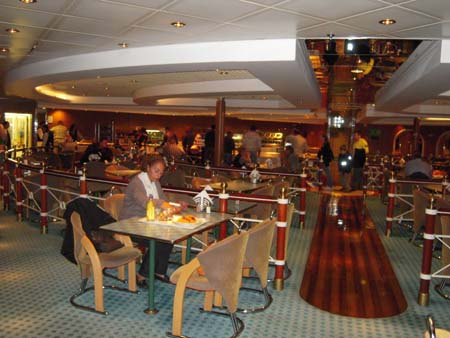
"Olympic Champion", the self-service (WS)
|
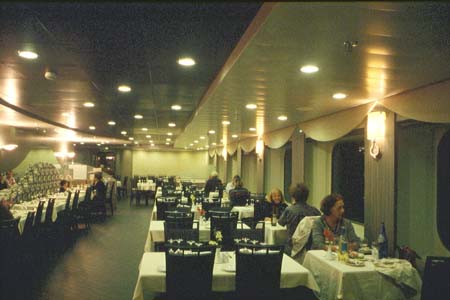
"Cruise Olympia" of Minoan, the restaurant (WS)
|
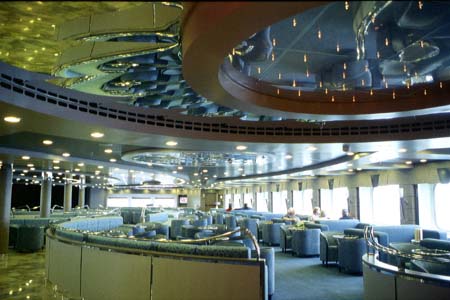
"Cruise Olympia", the forward-looking lounge (WS)
|
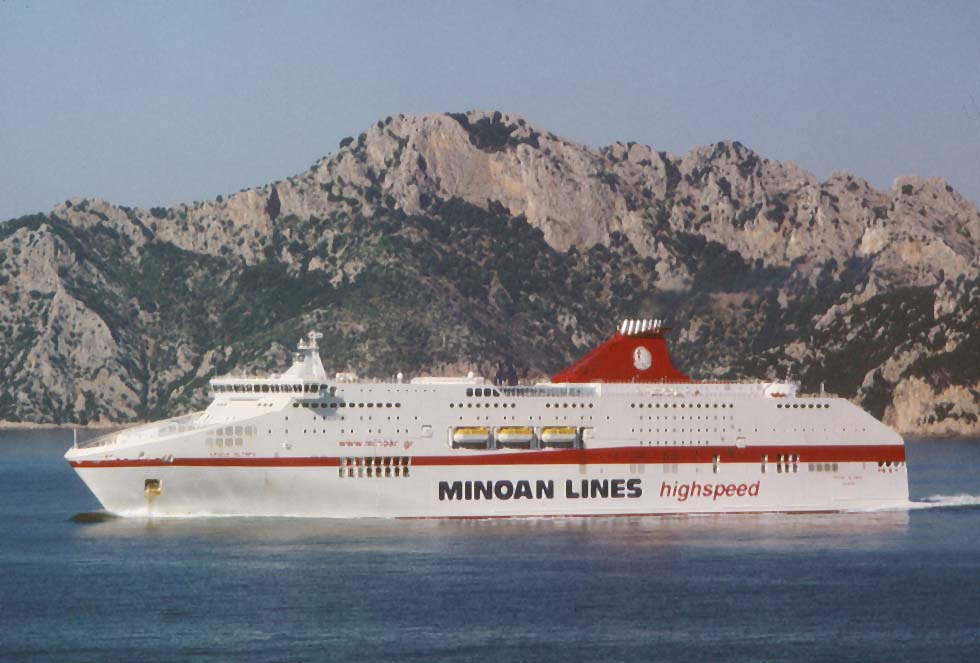
"Cruise Olympia" of Minoan, Patras - Ancona, Greek coast 2011 (WS)
Car ferries however are not the only survivors in regular passenger business. There are various passenger ferries, tourist boats, some passenger-cargo services and in remote regions there may be connections not listed anywhere. All that multitude of services, routes and operators worldwide is so overwhelming, that for every region only a short glimpse can be given, of course without fleet lists. Due to the complexity of the market and scarce information even by Internet, continuous updating is not always possible and a worldwide survey never can be fully comprehensive.
For more information see the relevant literature, e.g. 'Faehrschiffahrt der Welt' by Kai Ortel and Horst-Dieter Foerster, 'Die grossen Passagierschiffe der Welt' by Arnold Kludas, continued by Frank Heine and Frank Lose, Jane's High-Speed Marine Transportation, ShipPax, the German magazine Ferries, edited by Frank Heine with Frank Lose, Ships Monthly, other publications and the relevant Web sites - see chapter 03 Links. For USSR see Bruno Bock, Klaus Bock: Die roten Handelsflotten, Koehler 1992. For connecting trains click:
www.trains-worldexpresses.com
|